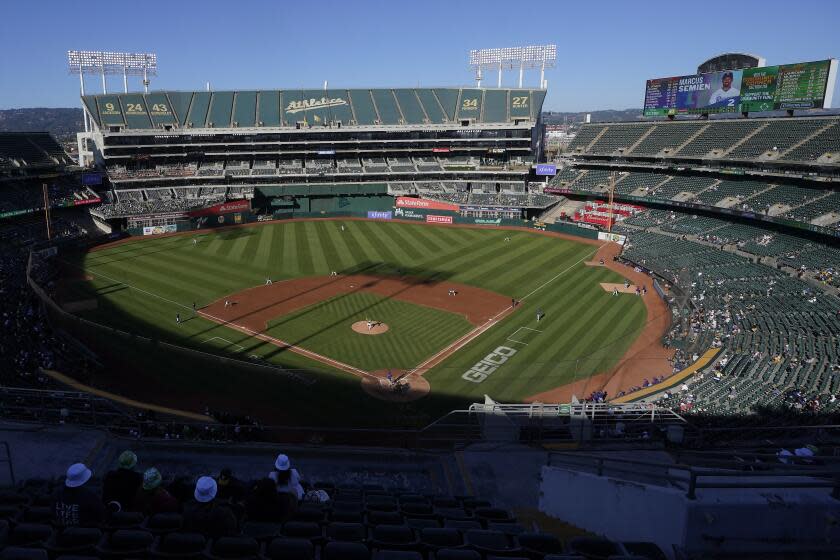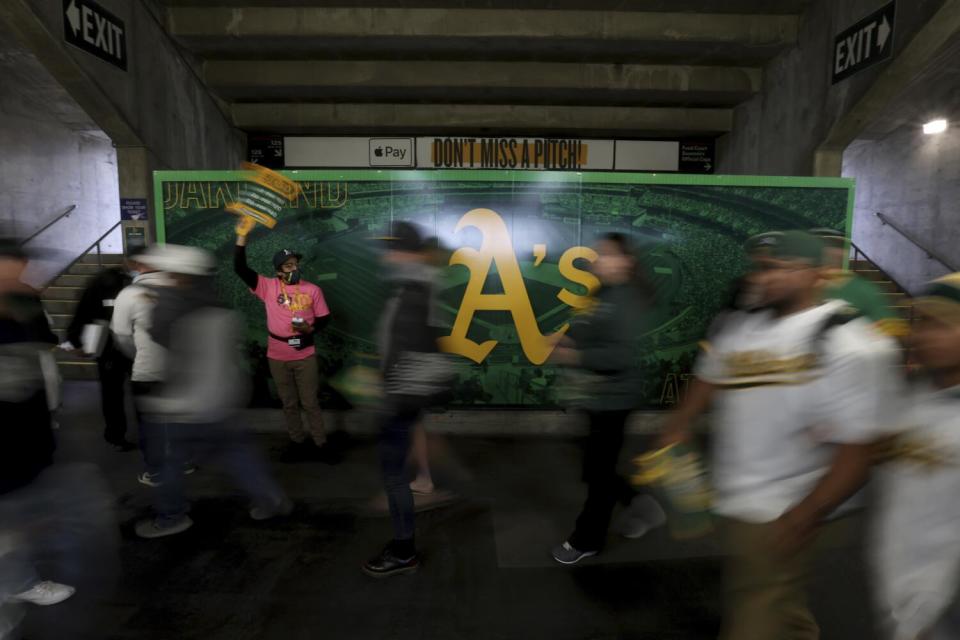Shaikin: John Fisher got his Vegas wish. Will he now try to hold the Oakland Coliseum 'hostage'?

The Oakland Coliseum, soon to be deserted by the Oakland Athletics, sits within an underdeveloped and overly industrial corridor within the city. Kevin Jenkins, the councilman who represents the area, would like to tell you a little about his district.
“We lack a major grocery store,” he said.
People need places to dine, places to shop, and places to gather.
“They need,” Jenkins said, “somewhere they can go for entertainment and have great memories for their families here in their hometown.”
What they do not need turns out to be exactly what they have: a 120-acre site, vacated by the last of three major sports teams to play there, ripe for development — and controlled by the guy who is moving the A’s to Las Vegas.
John Fisher, who owns the A’s, also owns a 50% stake in the Coliseum property. The city owns the other half.
Read more: Viva Las Vegas: MLB owners unanimously approve A's move from Oakland
“We need to develop that site,” Oakland Mayor Sheng Thao told me. “I hope he doesn’t hold it hostage.”
When the A’s insisted they were “rooted in Oakland,” they proposed a pretty cool plan to develop the Coliseum property. At the waterfront site at Howard Terminal, they would build a new ballpark and surrounding village.
At the Coliseum, they envisioned knocking down the stadium seats, retaining the field as a youth baseball field, and adding a park, an events center, shops, restaurants, offices and a technology campus.
And, because housing is the most urgent need there and everywhere in California, the A’s penciled in 3,000 new homes at each site. With homes come grocery stores.
“The reason that we acquired half of the Coliseum was because we believed strongly in the market of Oakland,” Fisher told me after the owners meetings concluded Thursday.
“It was not because we saw that, necessarily, as an alternative to Howard Terminal. I subscribed to the idea that, if we were going to make this kind of investment in Oakland in the form of building a new stadium at Howard Terminal, it was a bet on the future success of Oakland.
“I still believe in the future of Oakland. I think there are tremendous opportunities. It’s a great community. It has an amazing history.”
There is a potential gold mine in developing the Coliseum property. Should Fisher be striking it rich there, given at least the appearance that he would yank the A’s out of Oakland, then develop the Coliseum property and use the profits to help pay for the Las Vegas ballpark?
I asked Fisher whether he would commit to selling the land to the city of Oakland.
He wouldn’t say. He said he hasn’t had the time to consider it.
“I appreciate that you want specific answers to the Coliseum question,” he said. “To be honest, my mind right now is on — having had a unanimous vote for relocation to Las Vegas — understanding that there are a lot of people in my home community who are really upset with that decision, and understanding what that’s like for them.
“I understand that those feelings run deep. A’s fans are very passionate fans. I’m also excited about what the future looks like for our franchise, and the ability to finally have a place that can be our home for the next 55 years.”

There is a win-win outcome, just waiting for Fisher to embrace it.
The A’s still need a place to play for the three seasons between the end of their Coliseum lease and the targeted grand opening of the Las Vegas ballpark.
Thao said she was amenable to a short-term deal with the A’s, provided the A’s name stayed in Oakland and the city received priority in expansion. Those are both nonstarters.
Fisher said the name stays with the team.
“The Athletics are a storied franchise, dating back to 1901 in Philadelphia,” he said. “We want to make sure that history stays with the team when it comes to Vegas.”
And, said MLB Commissioner Rob Manfred: “We don’t even know if we’re going to have an expansion process, so I’m not in a position to bargain about where the expansion teams are going to go.”
What Thao could and should get: full ownership of the Coliseum site, to develop it in the best interest of the city.
Fisher has paid $40 million toward the A’s share of the Coliseum site, and he owes the remaining $45 million within six months of Thursday's relocation announcement. Alameda County, from whom Fisher bought his share in the land, should work with the city to repay Fisher, cancel the remaining debt, and leave the city with 100% ownership of the land.
Read more: Shohei Ohtani wins AL MVP, becoming first player to win by unanimous vote twice
In exchange, the A’s would get to play in the Coliseum until the Las Vegas ballpark is ready, and they would not have to consider playing in a minor league facility or barnstorming among stadiums in the interim.
Said Jenkins: “It is my intent to reach out to the A’s and see what their intention is and, hopefully in a diplomatic way, we can get to a resolution that includes the land being produced back and developed into something people want.”
Said Thao: “Of course the city would be very interested in having those conversations with John Fisher. We would definitely want to purchase that site if it is up for sale.
“I think that injustice is done when someone just sits on property, especially on a piece of real estate that is in deep east Oakland, which is an underserved and overlooked community and has been for decades.”
I asked Jenkins, the councilman, if Fisher needed to ensure the city reacquired the land.
“I won’t say he needs to,” Jenkins said. “I would hope that he would want to.”
This story originally appeared in Los Angeles Times.

